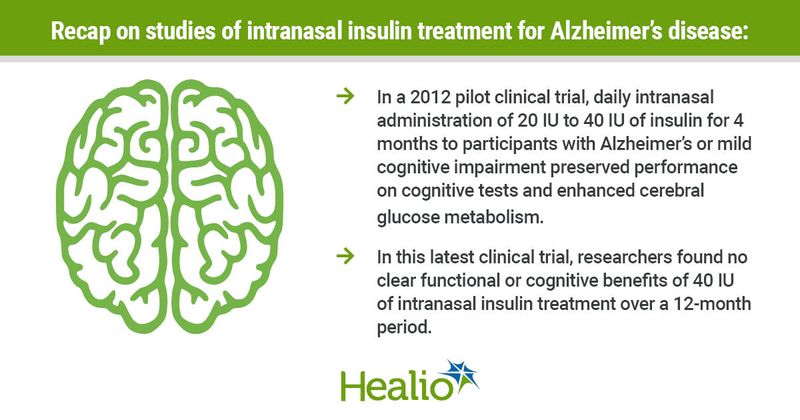Intranasal insulin shows no functional, cognitive benefits for older adults
Click Here to Manage Email Alerts
Intranasal insulin treatment over a 12-month period failed to provide cognitive or functional benefits to older adults with amnestic mild cognitive impairment or Alzheimer’s disease, according to a study published in JAMA Neurology.
“Insulin modulates aspects of brain function relevant to Alzheimer’s disease and can be delivered to the brain using intranasal devices,” Suzanne Craft, PhD, professor of gerontology and geriatric medicine at Wake Forest School of Medicine, and colleagues wrote. “To date, the use of intranasal insulin to treat persons with mild cognitive impairment and Alzheimer’s disease dementia remains to be examined in a multisite trial.”

Researchers conducted a randomized, double-blind clinical trial that included 289 participants (mean age, 70.9 years; 155 men). During the 12-month masked phase, approximately half the participants received 40 IU of insulin and the other half received placebo. Participants then completed a 6-month open-label extension trial.
According to the researchers, the first device that was used to administer treatment had “inconsistent reliability” and therefore was only used on 49 participants. They switched to a different device for the remaining 240 participants, although they acknowledged that this new device “had not been used previously” in patients with Alzheimer’s disease. The researchers designated this latter group the primary intention-to-treat cohort. This group was randomly assigned in an approximately 1:1 ratio to intranasal insulin or placebo.
Although there were no clinically important adverse events associated with intranasal insulin, Craft and colleagues found that regardless of treatment, there were no significant differences in participants’ Alzheimer’s Disease Assessment Scale-cognitive subscale 12 scores, cerebrospinal fluid outcomes, memory composite tests and MRI scans in the primary intention-to-treat cohort.
However, the researchers noted that the two devices used in the study had different modes of delivery. This may have affected how insulin entered participants’ central nervous systems, potentially complicating the results of the study. They said further research is needed with “reliable insulin delivery devices that have indicated the ability to elevate insulin in the central nervous system” to ascertain whether there is a therapeutic benefit of intranasal insulin in older adults with mild cognitive impairment or Alzheimer’s disease.
